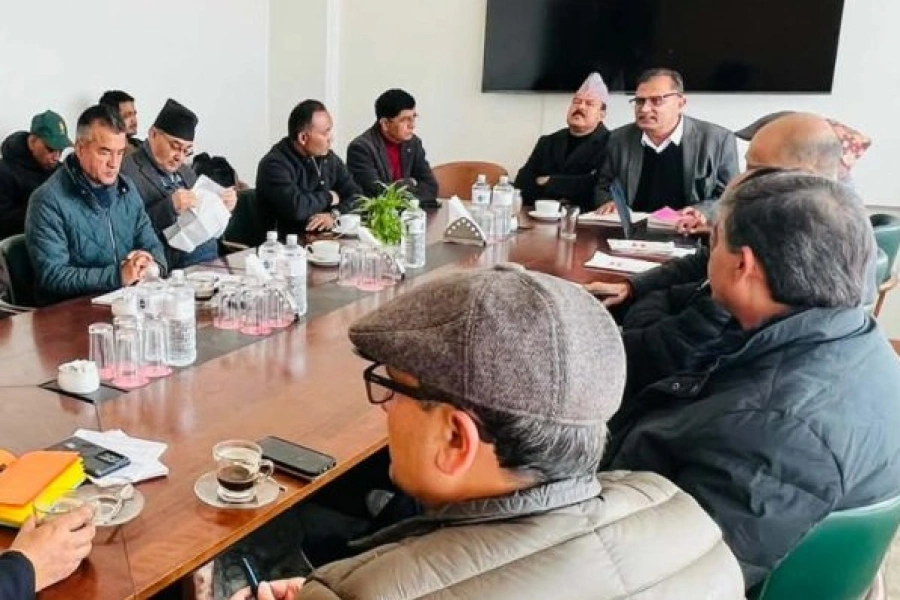Mountain agriculture in Nepal needs special emphasis as it is disconnected from basic services and facilities to farm, process and additional value creation to ensure socio-economic sustainability for the farmers.
Last December 11, International Mountain Day was observed globally with the common theme ‘Women move mountains’. The relationship between mountains and Nepal is axiomatic with the Himalayas and hilly area enclosing more than 80 percent of the country’s total land mass. In addition to this, Nepal is also the second most mountainous country in the world based on average height above sea level extending to 10,715 feet. According to statistics from FAO, the mountain region globally covers 27 percent of the land area and accommodates almost 1.1 billion people. Despite being geographically and climatically challenged, the mountain region is the repository of major ecosystem services which have been left unexplored in the realms. One of the primal forms of provisioning ecosystem services rendered by the mountain ecosystem is food and agriculture which still lacks an integrated and consolidated framework in Nepal for development.
Albeit the region is replete with a quaint and pristine landscape, the mountain livelihood in life often has floundered to maintain food security, or resilience against insidious global threats like climate change. More dominantly, mountain agriculture in the mountain territory is established on pastoralism, agro-pastoralism, or integrated farming system. Mountain agriculture as defined by the Euro Montana is an agricultural production system characterized by extensive local input and output production systems, oriented toward the production of high-quality agricultural products. Mountain agriculture in Nepal is depicted by small land holdings and family farming-based agriculture practices which are fragmented. The emphasis of mountain agriculture in the country is to secure food to consume for the family and later process or sell the surplus product to the market. Mountain agriculture in Nepal needs special emphasis as it is disconnected from basic services and facilities to farm, process and additional value creation to ensure socio-economic sustainability for the farmers.
Existing reality of mountain agriculture market
It can be easily discerned that mountain agriculture which is weakly integrated with the commodity market lacks competitiveness in comparison with the agricultural products originating from the lowlands in the country. The mountain population indulged in the production practices is incognizant of the negotiation and management skills that are indispensable for the economic success of the farms. Different INGO and NGOs along with governmental bodies and extension experts are oriented on disseminating adequate learnings of sustainability of mountain agriculture to the farmers. Despite this tremendous effort on a nation-wide scale, farmers are facing constant difficulty in marketing their agricultural products competitively to the market. Due to high constraints in mountain farming, the majority of the mountain farms are abandoning their farmlands and shifting toward developed centers for a better quality of life. The exodus of mountain farmers induces drastic negative impacts on the biodiversity maintenance and ecosystem services that mountain agriculture supplies to Nepal.
Different certification schemes: Organic?
Due to the complexity of farming, most agricultural farmers from the mountain region adhere to minimum usage of chemical fertilizers and pesticides which opens up the possibility of branding the mountain product with an organic label. However, initially, a robust organic certification system needs to be established by the state and the functioning of the certification regime should be financed by the state itself and not add any financial burden to the economically deprived mountain farmers. An extension support system can be formulated which can be a private actor to support the mountain farmers in the transitioning, and extension of the farms. Further, a certification body can be assigned to monitor the certification process and control the farms to produce quality organic mountain products. Thus, obtained mountain food products would be credible among the consumers who have showcased higher affinity to the products belonging to local heritage or coming from mountain territory. A practical example of this can be clearly illustrated with the increased demand for potatoes from Mustang or large cardamom from the Kanchenjunga landscape.
Other certification and branding strategies
The mountain territories of Europe acknowledging the constraints, and hardships of mountain agriculture have turned up with a denomination “Mountain Product” which can be used as a label to promote mountain food products in the country. Similar cases can be replicated in the context of Nepal, where strict legislation in defining the mountain product and the use of the label can be regulated by some competent body to authenticate the originality of the products belonging to the mountain region in Nepal. However, the implementation of such a system requires huge public sector involvement and coordination with certifying organizations to assure consumers of the authenticity of the mountain products. On the other hand, certain territories with the involvement of local governments can adopt territory approaches where they can sell the mountain products under the local territorial brand. A relevant example of this would be selling products from the mountain region of Karnali with territorial branding of the Karnali region. Adoption of all these certification schemes with proper government involvement can enhance the economic sustainability of the farmers from the mountain fetching premium prices in the market for the qualitative product.
Role of GMS and e-Commerce supply chain
In recent days, as eCommerce companies and supermarkets have exhibited an interest in supplying local products to consumers, they can equally contribute to assisting the farmers from the mountains by procuring the food products directly from the farmers with reduced post-harvest and handling losses and being more transparent in describing the products to the consumers.
What is missing in budget for agriculture?






































